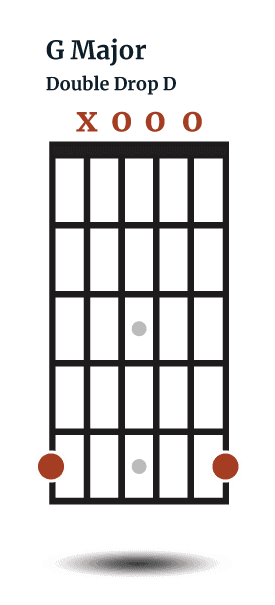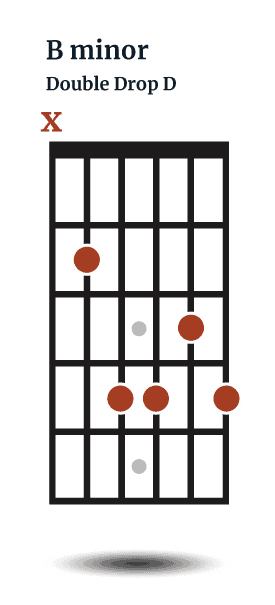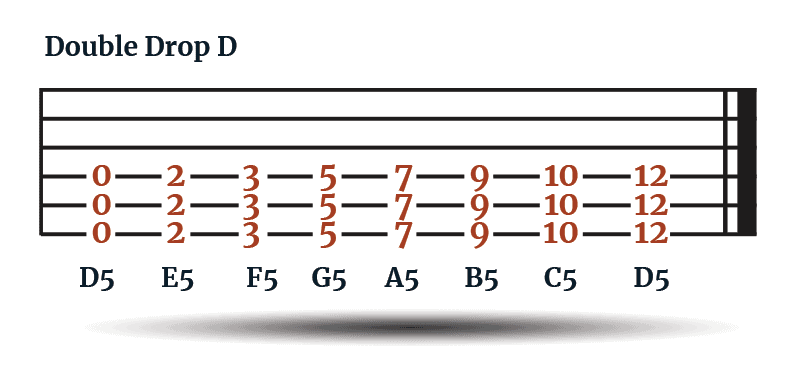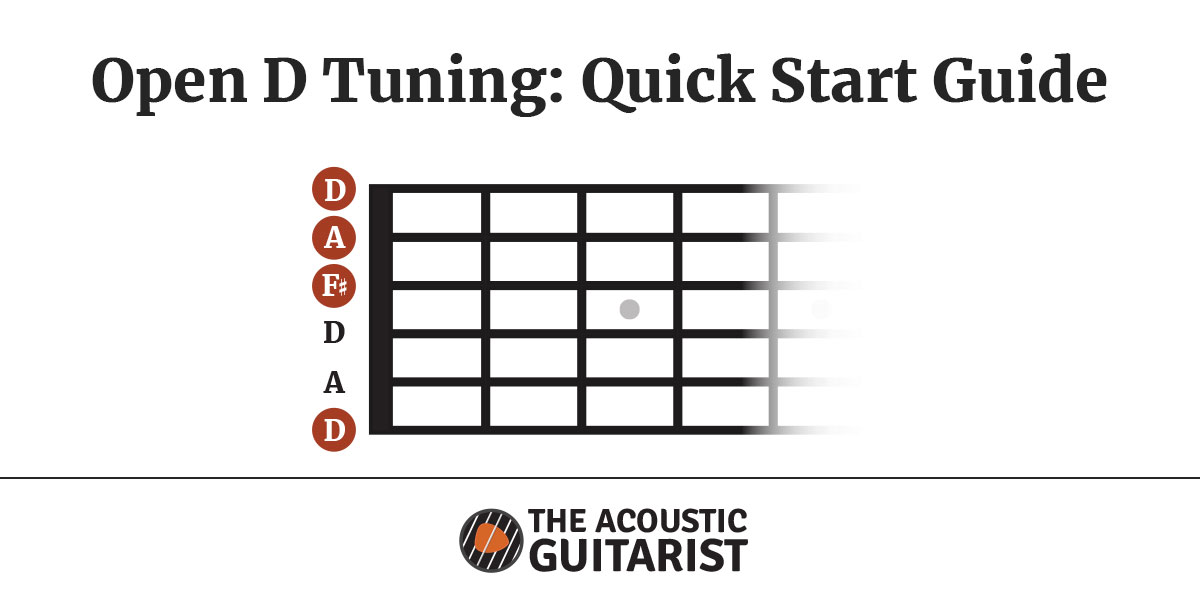Double drop D tuning (DADGBD) is a rich alternate tuning, that much like drop D, is perfectly suited to the acoustic guitar. Offering an expressive and expansive sound in the key of D while retaining enough familiarity, thanks to the middle four strings remaining unchanged.
As part of our series on alternate tunings for the acoustic guitar, in today’s article, I’m going to show you how to tune your guitar to double drop D and explain why you may want to consider using this tuning instead of standard tuning, especially in the key of D. We’ll also take a look at some useful chord voicings and list some of the great acoustic songs you may not realize are written in, and take full advantage of double drop D, such as ‘The Chain’ by Fleetwood Mac and ‘Going to California’ by Led Zeppelin.
This article gets a little in-depth, so, if you don’t have time to read it in its entirety, I’ve listed the main points below.
How to Tune to Double Drop D

To tune to double drop D simply detune both E strings (the 1st and 6th strings) a whole tone to D.
The three D strings, each being an octave apart provide a wide frequency range, adding greater depth when playing chords in the key of D. The benefits of drop D tuning (vertically aligned root and 5th) along with the open tuning feel of double drop D (the top four strings form a G chord) make this a versatile tuning, yet simple to remember and transition to from standard tuning.
| 1 | 2 | 3 | 4 | 5 | 6 |
| D | B | G | D | A | D |
If drop D is the simplest alternate tuning to play in and transition to from, double drop D is a close second as just one additional string is changed.
If you are unsure how to tune to double drop D, the clue is in the name. Double drop D simply means both the high and low E strings are tuned down a whole step to D.
This results in the fretboard being laid out as per the diagram below:
Tuning by ear
While you could always use a tuner, a faster and more convenient method is to use the open D (4th string)as a reference. The tuning creates octave intervals between the 6th and 4th string and the 4th and 1st two-octave interval between the 6th and 1st string. Another option is to reference the 3rd fret on the 2nd string (B).
Keep in mind, that detuning both the 6th and 1st strings may cause some instability with your remaining strings, so be sure to check strings 2 through 5 if something doesn’t quite sound right.
If you have trouble tuning using the 4th string as a reference, try coming at the D from below the reference note e.g. reduce the tension of the 6th and 1st strings more than you might usually, and then find the correct pitch by tuning up to the D.
The human ear is more conditioned to this approach and this also provides the added advantage of taking out any potential slack near the nut where the strings can sometimes stick.
The Open D5 Chord

Once in tune, strum an open D shape hitting all strings, but leave the 1st string open.
You should now hear a rich, full-bodied chord. But hold up a second, the chord isn’t a D major triad anymore, it’s now an open D power chord or D5.
The additional root notes (6th string — D, 1st string — D) along with the 4th string D, spread across three octaves give the chord more width between frequencies, resulting in a fuller, more expansive sound, despite technically being a power chord (which technically isn’t a chord at all) due to being constructed from the root and 5th note of the scale only.
This is a great example of why alternate tunings can be so useful for guitarists, as there’s no other way to generate such a rich, full-sounding D5 chord in standard tuning
And, if you like, you can still play a D major by placing your pinky on the fourth fret of the 6th string instead of playing the open string.
Why Double Drop D is such an effective tuning
It was during a rehearsal that an old friend and one of the most talented guitarists I have known suggested I detune my 1st string to D.
I was already playing in drop D, as I almost always did, but as the song we were playing was in the key of Dm, he suggested this small tweak might add a little extra to what I was playing.
It did, and I’ve been a fan since, predominantly playing in standard, drop D, and double drop D from that day on.
Like drop D, double drop D is a great tuning to experiment in offering a more folksy vibe than perhaps the more rock-orientated drop D. However due to the construction of the tuning the benefits of drop D are very much still on offer with regard to richer sounding power chords and accessible drone notes due to the interplay between the 4th and 6th strings.
However, it’s also a tuning that provides an open tuning feel, when utilizing the top four strings (which form a G chord) as these intervals are also present in open G tuning. In fact, detuning the A string a whole step to G will result in the guitar being tuned to open G tuning (DGDGBD) which is just a half step away from open D tuning (DADFAD)
A simple tuning to remember
But, perhaps the biggest benefit to double drop D is its accessibility from standard tuning. If you already know drop D, it’s relatively easy to slip between standard, drop D, and double drop D allowing you to take advantage of each tuning and the advantages each might offer with regard to specific chord voicings or availability of an underlying open string drone.
Double drop D can also serve as a stepping stone to more sophisticated tunings such as Celtic tuning ( DADGAD) as the second string is the only string changed, moving up a whole step from B to A.
In my experience learning more elaborate tunings and remembering their structure becomes a lot easier when you have ‘stepping stone’ tunings such as double drop D to work from.
Songwriting
Anyone with experience playing in alternate tunings understands how powerful alternate tunings are for songwriting. Like drop D, double drop D removes some of the basic foundations we are accustomed to, forcing a more ‘out-of-the-box approach’, particularly if unfamiliar with the tuning.
And along with drop D may also facilitate a more electric approach to the acoustic guitar as power chords and expanded power chords become more accessible due to the root and 5th lining up vertically on the fretboard.
However, much like drop D retaining the four strings, 2 through 5 provide a level of familiarity, facilitating simple runs during chord progressions.
Tuning to double drop D may also force you out of your usual comfort zone creatively. For example, if you don’t usually write in D, drop D, double drop D and DADGAD (Celtic Tuning) offer up tasty open note drones that will lead you directly to writing in this key. It’s no surprise a lot of Irish music is written in the key of D.
Is double drop D anything like open d tuning?
No. Open tunings are tunings where the guitar is tuned to a specific chord. In the case of open D, the guitar is tuned to play a D major chord (requiring the notes D, A, and F#) when all strings are played open.
| 1 | 2 | 3 | 4 | 5 | 6 |
| D | A | F# | D | A | D |
DADGAD tuning?
I’ve mentioned DADGAD tuning a couple of times above. For those unfamiliar with DADGAD tuning, it’s an alternate tuning that shares many of the same intervals (distance between notes) as double drop D. It is particularly well suited to Celtic music (hence being referred to as Celtic Tuning). I’ve written a full article explaining the ins and outs of DADGAD tuning, you can read it here if interested.
Double Drop D tuning Chords
Open Chords

One of the real benefits of double drop D is the number of open chord voicings that require just a small adjustment from standard tuning.
In practical terms, as both E strings have been detuned a whole step we need to raise the pitch of notes played on the 1st or 6th string (formerly the high and low E strings) a whole step (2 frets) to compensate. In simple terms, this means the open string E is now found on the 2nd fret of the 1st and 6th strings.
An example of this is the D major chord, we discussed above. By simply fretting the fourth fret on the 1st string, instead of the second fret in standard tuning we now have D major chord.
If playing an open A chord, we just need to fret the 2nd fret of the 1st string which is vertically aligned with the notes on the B, G, and D strings, allowing the chord to be formed using just one finger.
I’ve added chord diagrams below for all open Major and minor chord variations, however, keep in mind there are many different ways to voice chords.
Major Open Chords — Double Drop D Tuning
 |  |  |  |
 |  |  |
Minor Open Chords — Double Drop D Tuning
 |  |  |  |
 |  |  |
Other Useful Chords
Because the middle four strings remain the same as for standard tuning some standard chord shapes when played in double drop D become extended chords.
For example, a chord shape such as C Major becomes an extended chord (extended chords are triads e.g. root, third and fifth, that utilize additional notes beyond the 7th scale degree). The C Major becomes a Cadd9 chord (the 1st string D is 9 scale degrees above the root due to being an octave higher), a more sophisticated chord voicing.
Another example of this is the Am shape, which when played in double drop d tuning becomes an Amadd11.
 |  |
Power Chords
Power chords, due to the vertical alignment of the root and 5th on the 6th, 5th, and 4th strings become simpler to play in double drop D tuning, especially on the acoustic guitar. And, as the 1st string is not included, is the same as if playing in drop D.
A simple way to approach power chords in either tuning is to memorize the major scale on the 6th D (formerly E) string as per the tab below, adding the fifth and fourth strings which include the 5th scale degree and octave higher root note.

Adding the note two frets higher up the neck on the 3rd string adds an additional 5th and including the second string one fret higher adds another 5th giving the chord a much fuller sound.

Barre Chords
Minor Chords
As the A string is not adjusted for double drop D tuning, root barre chords using the Am shape rooted on the A string retain the same structure as for standard tuning, only the 1st string is muted.
This doesn’t change the quality (e.g. minor) of the chord itself as the note included on the 1st string is already included in the chord on the D string two frets lower on the neck.
The diagram below shows the guitar’s fretboard in standard tuning and highlights the notes required for a Bm chord using an Am barre shape. As you can see the notes played on the D string are repeated on the high 1st (high E string). This means we can safely mute the 1st (high D string in double drop D tuning) without affecting the quality of the chord e.g. it retains its minor quality.

However, when playing B minor, D minor, and G minor which all include the D as the root, flat third, or fifth we can incorporate the open 1st and 6th strings giving the chord more depth.
The easiest way to play these chords in double drop D is to place the index finger on the A string root rather than barring the middle strings which can be difficult to allow the 1st string to ring out.
Technically this is no longer a barre chord, however, it’s an easy position to transition to from an Am barre shape.
 |  |  |
Major Chords
We can also incorporate the 1st and 6th strings when playing D and G major. However, there is a simple shape for playing major barre chords in double drop D.
In double drop D tuning the 1st 4 strings when played open form a G major chord. As the octave is always two strings up (A string) from the D string and two frets lower on the neck we can simply root on the A string using a normal A major barre shape and incorporate the 1st string on the same frets as the 3 strings above it, as the 1st string and 4th strings are tuned to D and utilize the same notes.
The diagram below shows this in action.
 |  |  |
We can also root from the 6th string using the chord shapes shown below for both major and minor chords. However, the major chord shape can be difficult to fret especially within the first four frets and both tend not to sound as rich as the examples above.
 |  |
*Keep in mind there are many different voicings for all chords. The chord shapes shown above are the chord shapes I have found useful in double drop D tuning.
double drop d Songs
Double drop D tuning is a tuning that has been used across many genres but tends to find its home in folk, especially fingerstyle, folk-rock, and Celtic music.
Below are a handful of acoustic-based songs written in double drop D. ‘The Chain’, in particular, is a great example of double drop D tuning by a true alternate tuning aficionado in Lindsay Buckingham, (formerly) of Fleetwood Mac.
| The Chain * Please note this song is indeed in double drop D tuning. There is a typo on the page I have linked to. | Fleetwood Mac |
| Going to California | Led Zeppelin |
| Norwegian Wood The link shows a cover version TAB by Colin Hay. | The Beatles |
| Black Water | The Doobie Brothers |
| Cinnamon Girl | Neil Young |
| Overkill | Men at Work |
| Bryter Layter | Nick Drake |
| If I were a carpenter | Ramblin Jack Elliot |
Overkill by Colin Hay (a bit of a musical hero of mine) and Men at Work, while being originally an electric guitar-based song from the album Cargo, released in 1983 is perhaps even better known for the acoustic version thanks to Colin Hay appearing in the Scrubs episode ‘my finale’ in 2003. If you are not familiar with the song, I’d strongly encourage you to take a listen, it’s just a great song if not a great example of double drop D tuning.
How to play Overkill in double drop D
Summary
While there’s always more that could be covered when discussing alternate tunings of any kind, the information above should help you become familiar with double drop D tuning and teach you how to take advantage of the unique voicings on offer. If you are interested in how to apply this tuning to fingerstyle guitar or would like more information on power chords in double drop D tuning I have covered this in more depth in the article on drop D tuning which can be found here, just keep in mind the high E string is tuned to D in double drop D tuning.




